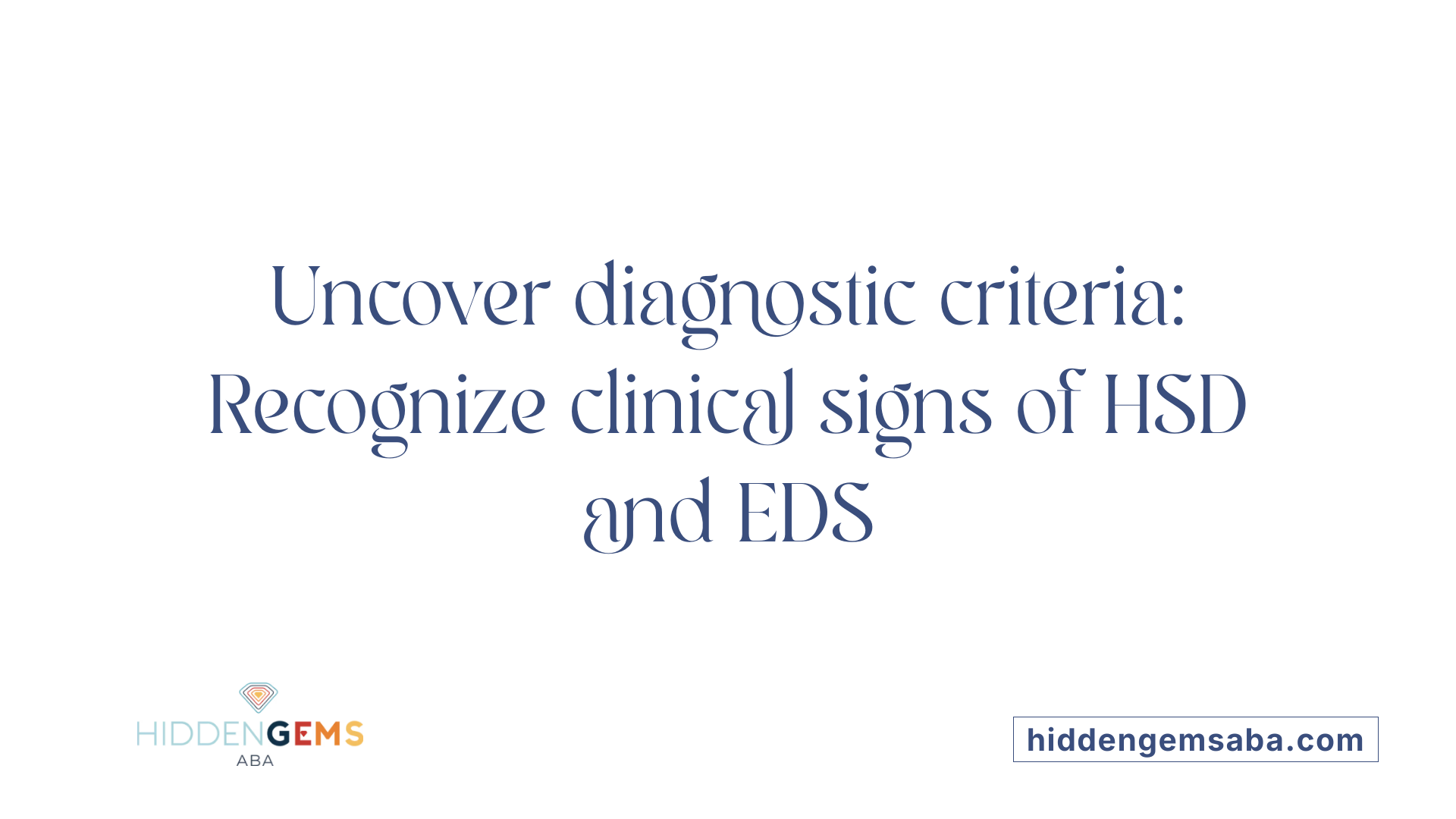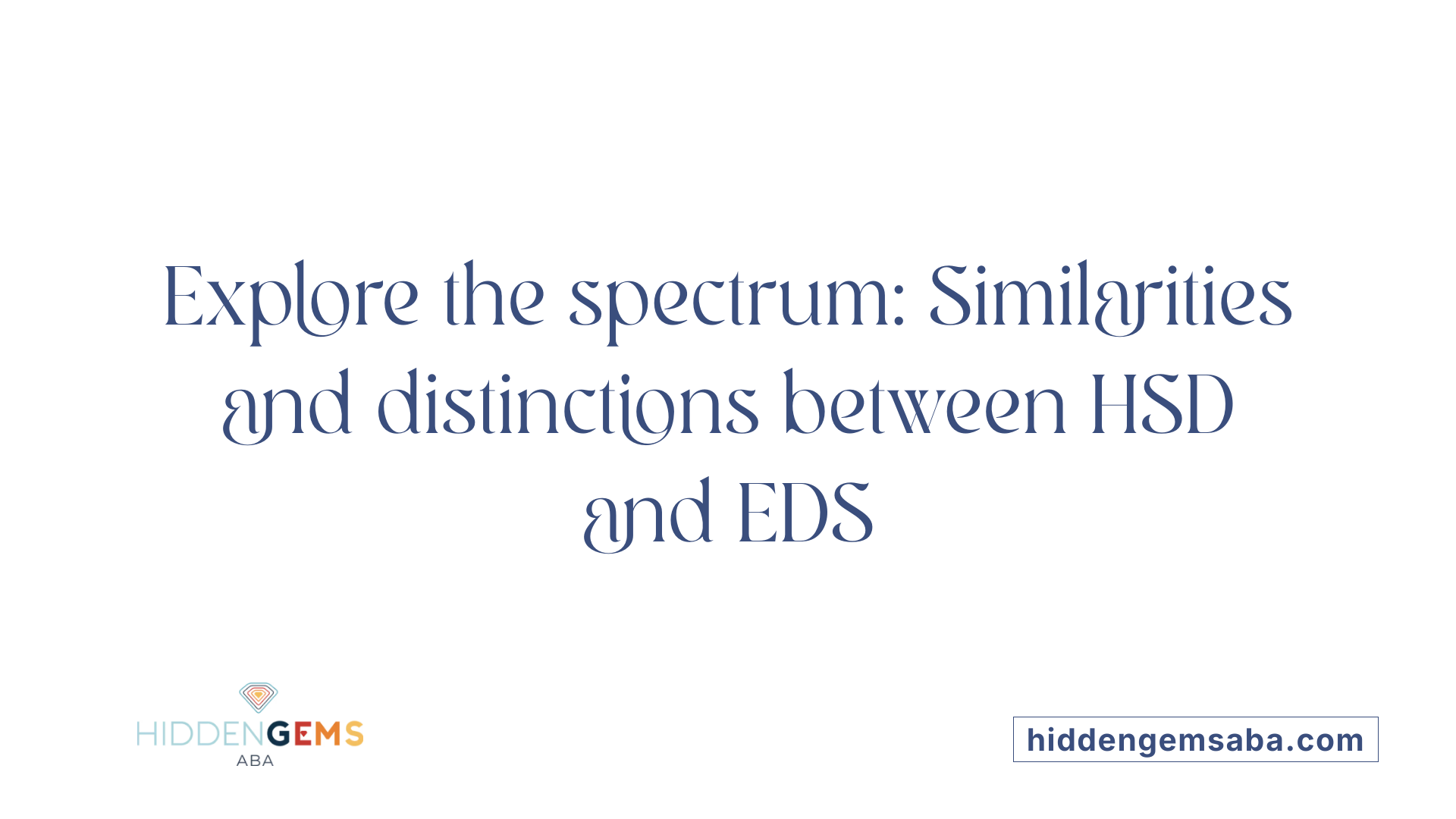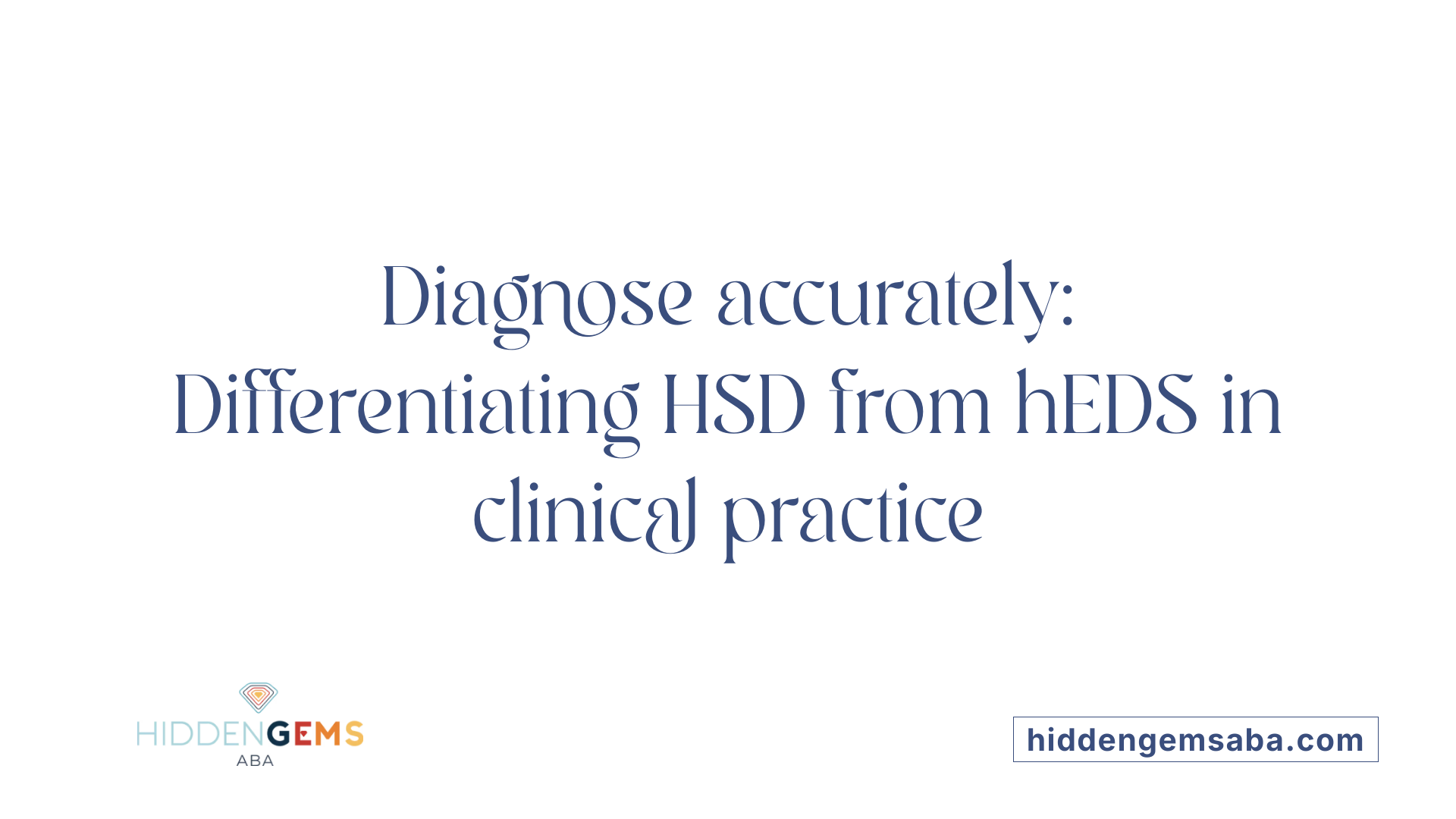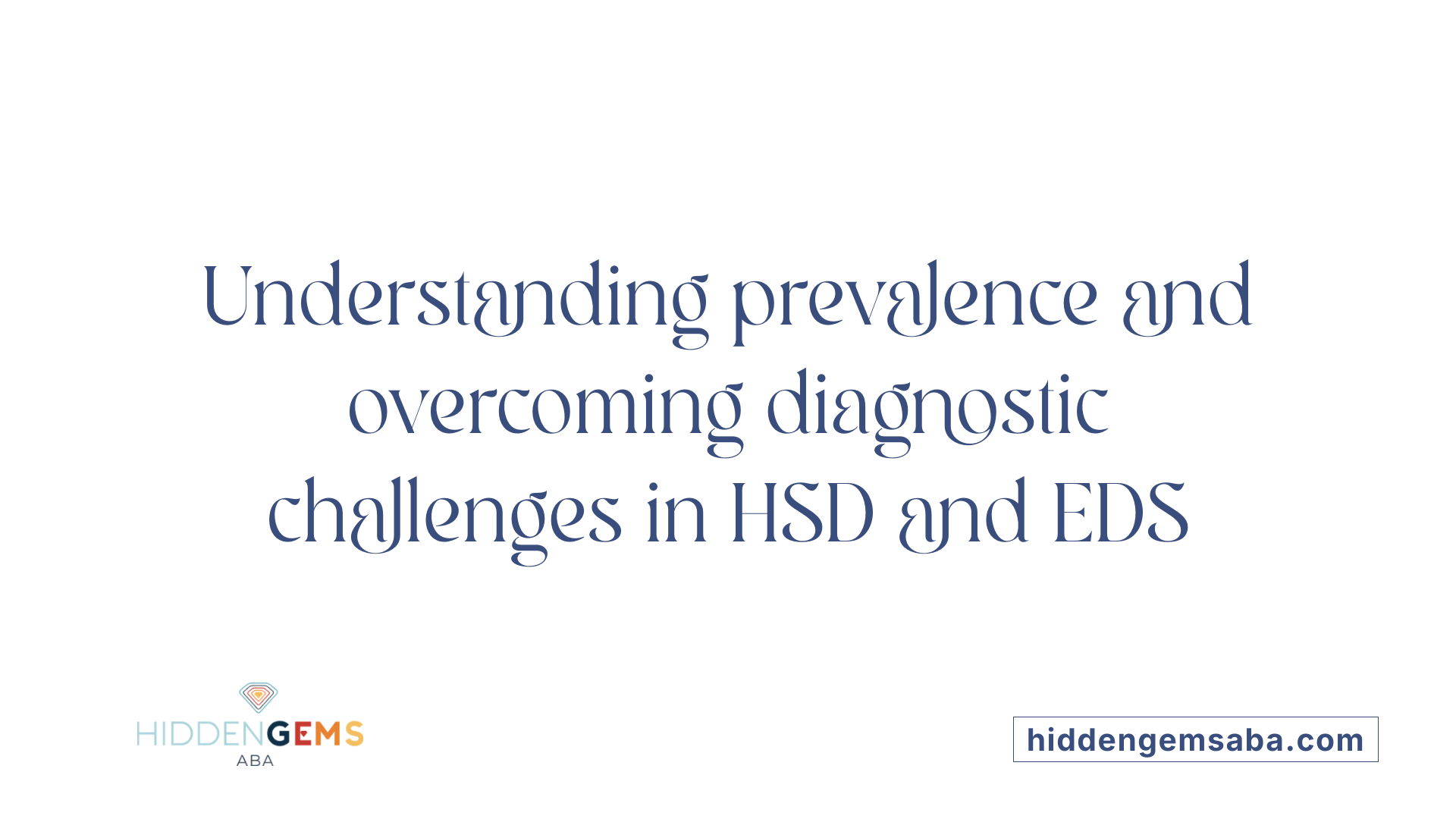A Comprehensive Guide to Hypermobile Disorders
Hypermobility spectrum disorders (HSD) and Ehlers-Danlos syndromes (EDS) are related connective tissue conditions that primarily affect joints and skin, but they differ in their clinical presentation, severity, and diagnostic criteria. This article explores their features, diagnosis, management, and long-term impacts to help readers understand these complex disorders and their distinctions.
Clinical Features and Diagnostic Criteria of HSD and EDS

What are the clinical features and diagnostic criteria for HSD and EDS?
People with hypermobile Ehlers-Danlos syndrome (hEDS) often exhibit marked joint hypermobility, which can lead to repeated dislocations, joint instability, and chronic musculoskeletal pain. Their skin may be unusually stretchy (hyperextensible), and they can develop features like unexplained stretch marks (striae), atrophic scars, and prolapse of internal organs. Additional systemic signs include long limbs (arm span greater than or equal to height), mitral valve prolapse, and aortic root dilation.
The diagnosis of hEDS relies on a set of clinical criteria defined by the 2017 International Classification. These criteria include generalized joint hypermobility measured by the Beighton Score, systemic features of connective tissue involvement, a positive family history, and data from physical assessment. Importantly, other connective tissue disorders and genetic syndromes need to be excluded to confirm a diagnosis.
In contrast, Hypermobility Spectrum Disorder (HSD) applies to individuals who experience hypermobility-related symptoms such as pain, dislocations, or soft tissue injuries but do not meet the full criteria for hEDS. These individuals may have localized hypermobility or generalized hypermobility with milder or fewer systemic features.
Since there are no specific laboratory tests for either condition, current diagnosis is purely clinical. A thorough physical examination and detailed medical history are essential. Healthcare providers also rule out other similar disorders, such as Marfan syndrome, osteogenesis imperfecta, or autoimmune conditions, to ensure an accurate diagnosis.
| Condition | Main Features | Diagnostic Approach | Additional Notes |
|---|---|---|---|
| hEDS | Joint hypermobility, skin hyperextensibility, dislocations, skin scars | Meets 2017 criteria including Beighton score, systemic features, family history | No specific genetic test, diagnosis based on clinical signs |
| HSD | Symptoms related to hypermobility like pain and dislocations, but not full hEDS criteria | Clinical assessment focusing on symptoms and hypermobility | Broad spectrum; often overlaps with mild or asymptomatic hypermobility |
Both conditions require careful assessment and exclusion of other disorders with similar features to ensure correct diagnosis and management.
Differences and Similarities Between HSD and EDS

What are the differences and similarities between Hypermobility Spectrum Disorder (HSD) and Ehlers-Danlos Syndrome (EDS)?
Hypermobility Spectrum Disorder (HSD) and Ehlers-Danlos Syndrome (EDS), especially the hypermobile type (hEDS), are conditions related to connective tissue that primarily involve joint hypermobility. Historically, many patients with hypermobility were diagnosed with joint hypermobility syndrome (JHS), but recent classification updates have introduced more precise terminology.
HEDS is now recognized as the most common hereditary connective tissue disorder, characterized by generalized joint hypermobility, skin features, and tissue fragility. HSD, on the other hand, describes a range of hypermobility-related symptoms where individuals experience joint instability, pain, or injuries but do not meet the full clinical criteria for EDS.
The main distinction lies in diagnostic criteria. EDS, specifically hEDS, requires meeting certain strict clinical features such as specific skin, joint, and musculoskeletal manifestations, along with systemic symptoms. HSD is diagnosed when the hypermobility causes problems but does not fulfill these strict criteria.
Although both share common symptoms like joint pain, dislocations, and fatigue, EDS tends to present with additional features like skin hyperextensibility, easy bruising, and more significant tissue fragility. This difference is crucial for guiding management and understanding prognosis.
Relationship between HSD and EDS (hEDS)
Research shows that HSD and hEDS likely represent points along a spectrum of hypermobility-related disorders. Some experts suggest viewing these conditions as part of a continuum, with HSD being a broader category encompassing less severe or less tissue-fragile manifestations, and hEDS representing a more pronounced phenotype.
Management approaches for both conditions are typically similar, involving physiotherapy, pain control, and preventing joint injuries. However, understanding the specific diagnosis assists in monitoring for potential complications, such as vascular issues in EDS.
Shared and distinct symptoms
| Feature | EDS (hEDS) | HSD | Explanation |
|---|---|---|---|
| Joint hypermobility | Yes | Yes | Present in both; assessed through Beighton score. |
| Skin features | Often hyperextensible, fragile | Usually normal or only mildly affected | More prominent in EDS, especially other types. |
| Dislocations and instability | Common, recurrent | Variable, less frequent or severe | Both involve joint problems; severity varies. |
| Tissue fragility | Yes | Rare | Significant in EDS, minimal in HSD. |
| Systemic symptoms | Frequently include organ, cardiovascular, or skin findings | Usually absent or mild | Systemic involvement is more characteristic of EDS. |
| Genetic testing | Currently lacking for hEDS and HSD | Absent or unconfirmed | Diagnosis primarily clinical; genetic causes for hypermobility remain under investigation. |
Implication of genetic and clinical variation
Most forms of EDS, including the hypermobile type, lack definitive genetic markers, making diagnosis reliant on clinical criteria. HSD is similarly diagnosed through symptoms and physical exam finding. This overlap and lack of genetic testing underscore the importance of thorough clinical assessment.
Understanding the subtle differences helps in tailoring patient management, predicting possible complications, and guiding future research to identify genetic markers, which could refine diagnosis and treatment further.
Management Strategies for HSD and EDS
What management strategies are recommended for HSD and EDS?
Managing hypermobility spectrum disorders (HSD) and hypermobile Ehlers-Danlos syndrome (hEDS) requires a comprehensive, personalized approach that addresses the various symptoms and potential complications.
One of the main treatments includes physical therapy aimed at strengthening muscles around hypermobile joints. This helps improve joint stability and reduces the risk of dislocations and injuries. Physical exercises are often designed to enhance proprioception (body position awareness) and reinforce joint support.
In addition to physical therapy, occupational therapy can help individuals adapt their daily activities to minimize joint stress and prevent injury. Supportive devices such as braces, taping, splints, and orthotics may be used to stabilize affected joints and alleviate pain.
Manual therapy techniques, including gentle joint mobilizations, can sometimes reduce discomfort, but should always be performed by trained professionals experienced with connective tissue disorders.
Lifestyle modifications are crucial. Patients are advised to modify activities that strain their joints, avoid hyperextension, and incorporate regular, low-impact exercise routines such as swimming or cycling. Education about joint protection, energy conservation, and symptom management empowers patients to take control of their condition.
Psychological support plays a vital role since chronic pain and functional limitations can impact mental health. Counseling or support groups can provide emotional resilience and help manage anxiety or depression associated with living with a lifelong condition.
Monitoring extends beyond musculoskeletal health. Patients with HSD and hEDS should have regular checkups for possible multisystem involvement, especially cardiovascular issues like mitral valve prolapse or aortic dilatation, which require cardiological assessment.
Overall, these conditions demand ongoing, multidisciplinary management focused on symptom relief, injury prevention, and improving quality of life. While current treatments are mainly aimed at symptom management, research continues to seek more targeted therapies for these connective tissue disorders.
Differentiating hEDS and HSD in Clinical Practice

How can I differentiate between hypermobile Ehlers-Danlos Syndrome (hEDS) and Hypermobility Spectrum Disorder (HSD)?
Distinguishing between these two conditions involves a detailed clinical assessment based on specific criteria. For hEDS, the 2017 guidelines require the presence of generalized joint hypermobility, which is often measured using the Beighton score — a simple scoring system where a score of 5 or higher in adults suggests hypermobility.
Beyond joint mobility, hEDS diagnosis includes additional features such as systemic signs like soft or velvety skin, easy bruising, recurrent dislocations, and musculoskeletal complications like hernias or scoliosis. Family history of similar symptoms and signs of connective tissue involvement are also significant.
In contrast, HSD covers a spectrum of hypermobility-related problems that do not fulfill all hEDS criteria. People with HSD often experience joint pain, frequent sprains, and instability, but they lack the characteristic skin findings or systemic features required for an hEDS diagnosis.
The assessment also involves ruling out other connective tissue disorders like Marfan syndrome or osteogenesis imperfecta. This comprehensive approach ensures accurate diagnosis.
Use of the Beighton score and clinical signs—the Beighton score is crucial in evaluating joint hypermobility; however, the overall diagnosis depends on a combination of clinical signs beyond just this score.
Role of family history and systemic features—a positive family history can support an hEDS diagnosis, especially when systemic features like skin and organ involvement are present.
Exclusion of other connective tissue disorders—since other genetic disorders can cause similar symptoms, clinicians meticulously exclude conditions like Marfan syndrome, which affects the same systems but has distinct features.
This careful differentiation guides appropriate management strategies and helps predict potential complications, ensuring patients receive the most suitable care.
Inheritance, Long-term Effects, and Prognosis
What are the symptoms, inherited traits, and long-term effects of HSD and EDS?
HSD (Hypermobility Spectrum Disorder) and EDS (Ehlers-Danlos syndromes) are genetic conditions affecting connective tissues, which support skin, joints, blood vessels, and internal organs. They are primarily inherited in an autosomal dominant pattern, meaning a person can inherit the disorder from one parent with the condition.
Common symptoms include joint hypermobility, leading to instability, dislocations, and chronic pain. Many individuals also experience features like stretchy, fragile skin, easy bruising, and fatigue. Certain types of EDS, such as vascular EDS, may cause life-threatening issues like organ rupture or severe blood vessel damage.
Over time, both HSD and EDS can cause long-term complications such as early-onset osteoarthritis, joint degeneration, and persistent pain. Some types are associated with internal organ problems, including heart valve issues or gastrointestinal dysfunction. The severity varies widely depending on the specific subtype, with some facing serious internal or vascular risks.
While there is no cure for HSD or most forms of EDS, ongoing management focuses on symptom relief and preventing injuries. Multidisciplinary approaches—including physical therapy, pain management, and lifestyle adjustments—aim to enhance quality of life. Regular monitoring by healthcare providers is crucial to detect and address potential complications early.
How do these conditions impact long-term health and daily living?
The prognosis depends heavily on the type of EDS or presence of HSD. Many individuals live full lives with appropriate management; however, some face lifelong challenges such as chronic disability, joint problems, and internal health risks.
Fortunately, early diagnosis and tailored treatment plans can reduce the impact of symptoms. Education, physical support, and lifestyle modifications play vital roles in maintaining function and well-being.
In sum, the inherited nature of these disorders often leads to lifelong conditions characterized by ongoing physical issues and vigilance for serious complications. Continued research and comprehensive care are essential to improving outcomes and quality of life for those affected.
Epidemiology and Challenges in Diagnosis

What are the epidemiology, prevalence, and diagnosis challenges of EDS and HSD?
Ehlers-Danlos syndromes (EDS) and hypermobility spectrum disorders (HSD) are more common than traditionally believed, but many cases go unnoticed. The overall prevalence of EDS is estimated at roughly 1 in 5,000 individuals worldwide. Within this, hypermobile EDS (hEDS) is by far the most common, accounting for between 80% and 90% of all EDS cases. Less common types include classical EDS, affecting approximately 1 in 20,000 to 40,000 people, and vascular EDS, which is far rarer, around 1 in 100,000 to 200,000.
The combined prevalence of HSD and hEDS is roughly estimated at between 1 in 600 and 1 in 900, indicating these conditions are quite widespread.
Despite these figures, diagnosis remains challenging. Many individuals with hypermobility and related symptoms remain undiagnosed or misdiagnosed due to the broad spectrum of clinical presentations. The phenotypic variability — where symptoms range from mild to severe — complicates recognition.
Additionally, current diagnostic processes rely heavily on clinical criteria, such as the Beighton score for joint hypermobility, the presence of systemic features, and exclusion of other disorders, as there are no definitive genetic tests for hEDS and HSD. This reliance on clinical judgment, combined with overlapping symptoms with other connective tissue disorders (like Marfan syndrome or osteogenesis imperfecta), increases the risk of delayed diagnosis.
Many healthcare providers find it difficult to recognize these disorders early because of their complex, multisystem nature. As a result, sufferers often experience long waits for diagnosis, which can lead to increased risks of complications like joint damage, cardiovascular issues, and chronic pain.
In summary, while EDS and HSD are more prevalent than generally acknowledged, diagnosing them accurately remains difficult due to phenotypic variability, lack of specific lab markers, and the need for thorough clinical assessment. Better awareness and standardized diagnostic criteria are essential to improve early detection and management.
Navigating the Spectrum of Hypermobility Disorders
Understanding the distinctions between HSD and EDS, particularly hEDS, is essential for accurate diagnosis, effective management, and patient support. Both conditions require a multidisciplinary approach emphasizing symptom control and prevention of complications. Ongoing research and evolving diagnostic criteria aim to improve recognition and care, highlighting the importance of awareness among healthcare providers and patients alike. While these disorders have lifelong implications, personalized care strategies can significantly enhance quality of life and safety for affected individuals.
References
- Hypermobile Ehlers-Danlos Syndrome and Hypermobility Spectrum ...
- [PDF] Hypermobile Ehlers-Danlos syndrome (hEDS) vs. Hypermobility ...
- Hypermobile Ehlers-Danlos Syndrome and Hypermobility Spectrum ...
- What is HSD? - The Ehlers Danlos Society
- Ehlers-Danlos syndromes - NHS
- Ehlers-Danlos Syndromes and Hypermobility Spectrum Disorder
- Ehlers-Danlos Syndromes and Hypermobility Spectrum Disorders
- Hypermobile EDS and hypermobility spectrum disorders
- Clinical manifestations and diagnosis of hypermobile Ehlers-Danlos ...
- Is there a diffference between HSD and hEDS? - The EDS Clinic





